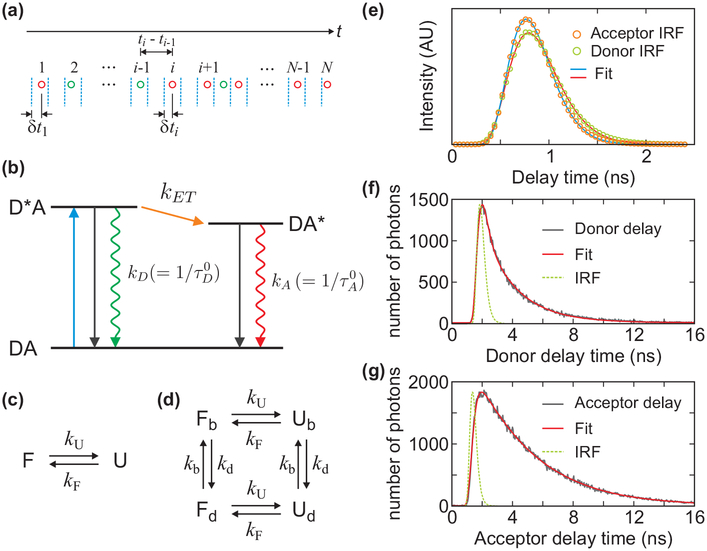Figure 2.
(a) A schematic representation (not to scale) of a sequence of donor (green) and acceptor (red) photons detected after pulsed laser excitations (blue dashed lines). For each photon, the arrival time (t) and the time δt between the laser pulse and the photon (delay time) is recorded. (b) Resonance energy transfer from donor to acceptor. After laser excitation (DA → D*A), the donor decays to the ground state or the energy is transferred to the acceptor (D*A → DA*) and decays to the ground state. kA and kD are the sum of the rates of the non-radiative (black solid arrows) and radiative (rippled arrows) decays of the acceptor and donor, respectively, which are the reciprocal excited-state lifetimes of the acceptor (τA0) and the donor in the absence of the acceptor (τD0). kET is the energy transfer rate from the donor to the acceptor. The mean donor delay time is equal to the donor lifetime, τD. The mean acceptor delay time is τA = τDA + τA0, where τDA is the donor excited-state lifetime on condition that the energy is transferred to the acceptor, which is not the same as the donor lifetime measured from the donor photons τD when there are fluctuations in kET (see eqs 6 and 7). (c) Two-state kinetic model and (d) four-state kinetic model that includes acceptor blinking. Subscripts b and d stand for the bright and dark states of the acceptor, respectively. (e) The instrument response functions (IRF) of the donor (green circle) and acceptor (orange circle) detection channels and the fits to the Gamma distribution (eq 20) (red and blue lines). t0 = 0.225 ns, a = 6.03 and kγ = 8.91 ns−1 for the donor channel and t0 = 0.234 ns, a = 6.84 and kγ = 11.0 ns−1 for the acceptor channel. (See Supporting Information (SI) for the dependence of the IRF on the count rate and wavelength of photons.) (f and g) Donor and acceptor delay time distributions from the photon trajectories of α3D. The experimental data (grey) was fitted to the convolution (red) of IRF (green dashed line) with a biexponential function for the distribution in the donor channel (f). The acceptor delay time distribution was fitted to the convolution of IRF (green) with a function similar to eq 15, which consists of the biexponential donor lifetime distribution and the single-exponential acceptor excited-state lifetime distribution (g).

